各种时态的用法
英语中常见的八大时态(结构及用法)
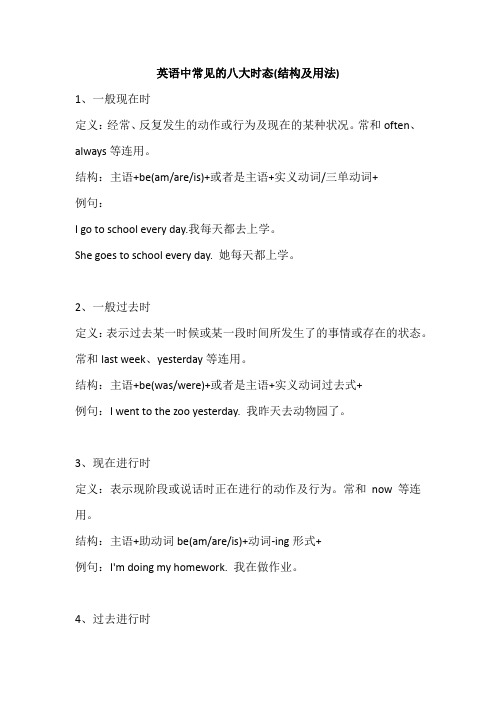
英语中常见的八大时态(结构及用法)1、一般现在时定义:经常、反复发生的动作或行为及现在的某种状况。
常和often、always等连用。
结构:主语+be(am/are/is)+或者是主语+实义动词/三单动词+例句:I go to school every day.我每天都去上学。
She goes to school every day. 她每天都上学。
2、一般过去时定义:表示过去某一时候或某一段时间所发生了的事情或存在的状态。
常和last week、yesterday等连用。
结构:主语+be(was/were)+或者是主语+实义动词过去式+例句:I went to the zoo yesterday. 我昨天去动物园了。
3、现在进行时定义:表示现阶段或说话时正在进行的动作及行为。
常和now等连用。
结构:主语+助动词be(am/are/is)+动词-ing形式+例句:I'm doing my homework. 我在做作业。
4、过去进行时定义:表示在过去某个时间点发生或进行的行为的事情。
常和at this time yesterday等或以when引导的谓语动词连用。
结构:主语+助动词be(was/were)+动词-ing形式+例句:When I got to the top of the mountain, the sun was shining. 我到达山顶时,阳光灿烂。
5、现在完成时定义:表示过去发生的动作对现在造成的影响或结果或过去的动作或状态持续到现在。
构成:主语+助动词(have/has)+动词过去分词+例句:I have lived here for more than twenty years. 我住在这儿二十多年了。
6、过去完成时定义:表示在过去某一时刻或动作以前完成了的动作,也可以说过去的时间关于过去的动作。
构成:主语+助动词(have/has)+动词过去分词+例句:She said she had never been to Paris. 她告诉我她曾去过巴黎。
英语中八种时态的具体用法

英语中八种时态的具体用法(1)一般现在时表示现阶段经常或习惯发生的动作或存在的状态,或说明主语的特征。
①一般现在时句子中常有的时间状语:often,usually,sometimes,always,every(day等),once/twice,a (week等), on (Sunday等),never,in the(morning等)。
如:They go to the Palace Museumonce a year.(他们每年去一次故宫)/ They oftendiscuss business in the evening.(他们经常在晚上商谈生意)②表示客观真理、事实、人的技能或现在的状态时句子里一般不用时间状语。
如:The earth turns round thesun.(地球绕着太阳转)/ Light travels faster thansound.(光传播比声音快)③表示十分确定会发生(如安排好的事情)或按照时间表进展的事情,用一般现在可以表达将来,句子中可以有将来时间。
如:The train for Haikou leaves at 8:00 in themorning.(开往汉口的列车上午8点开车)④在时间状语从句中(以when, after, before, while, until,as soon as等引导)与条件状语从句中(以if,unless引导),用一般现在时代替一般将来时,句子可以有将来时间。
如:Please ring me up as soon as you arrive inGermany.(你一到德国就给我打)/ If it rainstomorrow,we will have to stay at home.(如果明天下雨我们就只好呆在家)⑤一般现在时用于倒装句中可以表示正在发生的动作,动词以come, go为主。
如:Here comes the bus. (车来了)/ There goes the bell.(铃响了)。
英语中常见的六种时态的用法
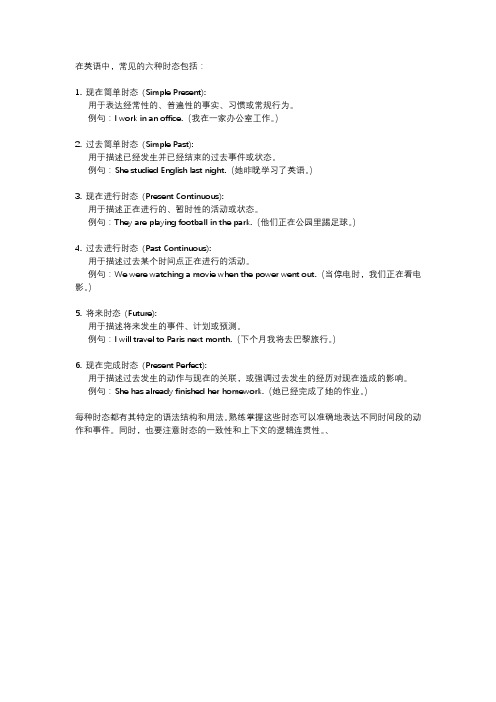
在英语中,常见的六种时态包括:1. 现在简单时态(Simple Present):用于表达经常性的、普遍性的事实、习惯或常规行为。
例句:I work in an office.(我在一家办公室工作。
)2. 过去简单时态(Simple Past):用于描述已经发生并已经结束的过去事件或状态。
例句:She studied English last night.(她昨晚学习了英语。
)3. 现在进行时态(Present Continuous):用于描述正在进行的、暂时性的活动或状态。
例句:They are playing football in the park.(他们正在公园里踢足球。
)4. 过去进行时态(Past Continuous):用于描述过去某个时间点正在进行的活动。
例句:We were watching a movie when the power went out.(当停电时,我们正在看电影。
)5. 将来时态(Future):用于描述将来发生的事件、计划或预测。
例句:I will travel to Paris next month.(下个月我将去巴黎旅行。
)6. 现在完成时态(Present Perfect):用于描述过去发生的动作与现在的关联,或强调过去发生的经历对现在造成的影响。
例句:She has already finished her homework.(她已经完成了她的作业。
)每种时态都有其特定的语法结构和用法。
熟练掌握这些时态可以准确地表达不同时间段的动作和事件。
同时,也要注意时态的一致性和上下文的逻辑连贯性。
、。
英语六种时态的用法

英语六种时态的用法一、一般现在时1. 表示现在经常反复发生的动作或存在的状态。
2. 表示客观事实或普遍真理。
3. 表示主语具备的性格和能力。
4. 表示将来一定会发生的动作。
5. 用于时间、条件、让步等状语从句中表将来。
6. 用于某些动词如come,go,leave,begin,start,stop等的进行时和某些表示位置移动的动词如go,come,leave等的现在进行时表将来。
二、现在进行时1. 表示现在正在进行的动作。
2. 表示当前一段时间内的活动或现阶段的活动。
3. 表示说话时正在发生或进行的动作。
4. 表示即将发生的动作。
5. 表示将来一定会发生的动作。
6. 用于某些动词如think,believe,expect,suppose,imagine等的进行时表示将来。
三、现在完成时1. 表示过去发生的动作对现在造成的结果。
2. 表示从过去某一时刻开始一直持续到现在的动作或状态。
3. 强调过去发生的动作对现在造成的影响和结果。
4. 表示某些已完成的动作对整个现在有决定性影响。
5. 常与副词just,already,yet,ever,never等连用。
四、过去进行时1. 表示过去某个时间点正在进行的动作或存在的状态。
2. 表示过去某个时间段内一直在进行的动作或状态。
3. 常与when,while等连用。
4. 与一般过去时相比,强调动作的持续性。
5. 在复合句中,常用于描述主句动作发生时的背景情况。
五、现在完成进行时1. 表示从过去某一时刻开始一直持续到现在的动作或状态,强调动作的延续性。
2. 表示过去某个时间段内一直在进行的动作或状态,强调动作的持续性。
3. 常与for,since等表示一段时间的连词连用。
4. 在口语中常使用现在完成进行时来表达一种轻松、愉快的语气。
5. 在复合句中,常用于描述主句动作发生时的背景情况或强调某种情感、态度等。
(完整)四种基本时态的用法

现在进行时:be+doing(1)表示说话时正在进行的动作,常与now连用,有时用look,listen等动词来表示now这一概念.如:Look!The car is coming!Listen! Someone is singing!The children are playing football on the playground now。
(2)表示现阶段正在进行的动作,现在进行时表示的动作不一定是说话时正在进行的动作,而是现阶段正在进行的。
此时,常与at present目前,this week这周,these days这几天等时间状语连用。
如:What are you studying these days?He is attending a international conference this week。
(3)现在进行时可以表示将来时间。
表示某个安排或计划好将要进行的动作,或即将开始或结束的动作。
这类动词有:arrive、leave、come、land、sleep、fall、return等词。
如:He is meeting the president tomorrow.The train is leaving in ten minutes。
The plane is landing in San Francisco on Tuesday morning.John is coming to the party tonight。
(4)动词的进行时通常与always、constantly等频率副词连用,表示重复动作,用来表达说话人的不满、厌倦或者赞赏、满意等情绪.如:It is always raining here.(表达说话人对雨的厌倦情绪)You are always making mistakes.(表达不满情绪)She is always helping others。
(表达说话人对这种行为的赞赏)**掌握动词原形变成ing形式的规律。
英语八大时态结构及用法
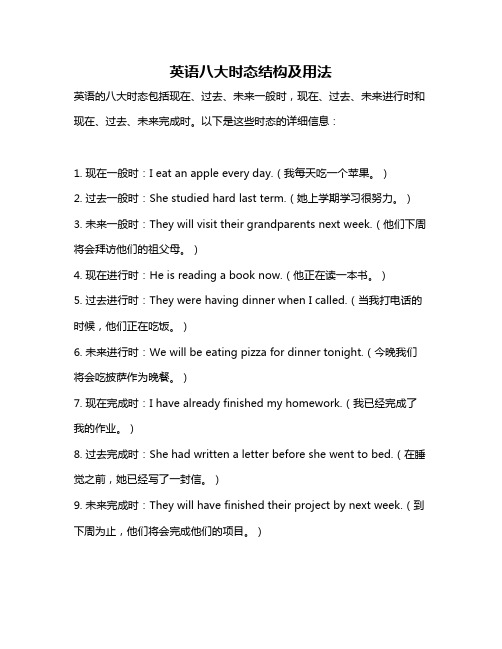
英语八大时态结构及用法
英语的八大时态包括现在、过去、未来一般时,现在、过去、未来进行时和现在、过去、未来完成时。
以下是这些时态的详细信息:
1. 现在一般时:I eat an apple every day.(我每天吃一个苹果。
)
2. 过去一般时:She studied hard last term.(她上学期学习很努力。
)
3. 未来一般时:They will visit their grandparents next week.(他们下周将会拜访他们的祖父母。
)
4. 现在进行时:He is reading a book now.(他正在读一本书。
)
5. 过去进行时:They were having dinner when I called.(当我打电话的时候,他们正在吃饭。
)
6. 未来进行时:We will be eating pizza for dinner tonight.(今晚我们将会吃披萨作为晚餐。
)
7. 现在完成时:I have already finished my homework.(我已经完成了我的作业。
)
8. 过去完成时:She had written a letter before she went to bed.(在睡觉之前,她已经写了一封信。
)
9. 未来完成时:They will have finished their project by next week.(到下周为止,他们将会完成他们的项目。
)
以上是英语八大时态的结构及用法,希望对你有所帮助。
16种英语时态(经典收藏版),太全了!
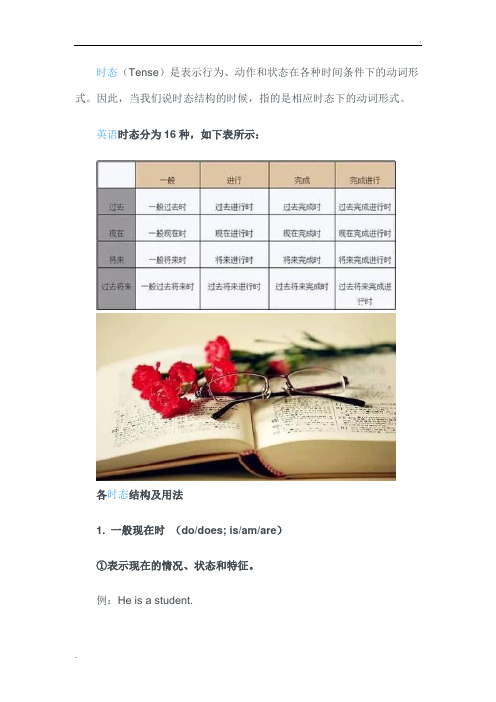
时态(Tense)是表示行为、动作和状态在各种时间条件下的动词形式。
因此,当我们说时态结构的时候,指的是相应时态下的动词形式。
英语时态分为16种,如下表所示:各时态结构及用法1. 一般现在时(do/does; is/am/are)①表示现在的情况、状态和特征。
例:He is a student.他是一个学生。
②表示经常性、习惯性动作。
例:He always helps others.他总是帮助别人。
③客观事实和普遍真理。
例:The earth moves the sun.地球绕着太阳转。
④表示一个按规定、计划或安排要发生的动作。
(常用于列车、客车、飞机或轮船时刻表)例:The next train leaves at 3 o'clock this afternoon.下一趟火车今天下午3点开车。
⑤主将从现:在时间、条件和让步状语从句中经常用一般现在表示将的来事情。
例:If it rains tomorrow, we will stay at home.如果明天下雨,我们会待在家里。
2. 现在进行时(am/is/are doing)①表示此时此刻正在发生的事情。
例:He is listning to the music now.他现在正在听音乐。
②表示目前一段时间内一直在做的事情,但不一定此时此刻正在做。
例:I am studying by using Qisu English APP this term.这个学期我一直在使用奇速英语APP学习。
③现在进行时可以表示将来的含义。
瞬时动词的进行一定表将来。
例:I am leaving.我要离开了。
持续动词的进行只有有将来的时间状语或有将来语境中才表将来。
例:I am travelling next month.下个月我要去旅行。
④现在进行时与频度副词连用,表示说话者或褒义或贬义的感情色彩。
例:He is always helping others.他总是帮助别人。
英语时态的用法

英语时态的用法英语时态分为以下几种:1. 现在时态:表示现在正在进行的动作或状态。
- 简单现在时:表示经常性、习惯性或客观真理。
例如:I like to read books.(我喜欢看书。
)- 进行时:表示现在正在进行的动作。
例如:He is playing football now.(他正在踢足球。
)- 完成时:表示已完成的动作对现在造成的影响或结果。
例如:I have finished my homework.(我已经完成了我的作业。
)2. 过去时态:表示过去发生的事情或状态。
- 简单过去时:表示过去某个时间发生的动作。
例如:I went to the park yesterday.(我昨天去了公园。
)- 进行时:表示过去正在进行的动作。
例如:We were watching a movie at that time.(我们那时正在看电影。
)- 完成时:表示过去已经完成的动作对过去另一个时间点的影响或结果。
例如:She had already eaten breakfast when I arrived.(我到达时她已经吃早餐了。
)3. 将来时态:表示将来要发生的动作或状态。
- 简单将来时:表示将来某个时间要发生的动作。
例如:I will go to Japan next year.(明年我会去日本。
)- 进行时:表示将来某个时间正在进行的动作。
例如:This time tomorrow, I will be flying to New York.(明天这个时候我会正在飞往纽约。
)- 完成时:表示将来某个时间已经完成的动作对将来另一个时间点的影响或结果。
例如:By this time next week, she will have finished her exams.(下周这个时候,她将已经完成了考试。
)4. 过去将来时态:表示过去将来要发生的动作或状态。
- 简单过去将来时:表示过去某个时间将要发生的动作。
英语中的各种时态及用法

英语中的各种时态及用法英语的时态(tense)是一种动词形式,不同的时态用以表示不同的时间与方式。
是表示行为、动作和状态在各种时间条件下的动词形式。
因此,当我们说时态结构的时候,指的是相应时态下的动词形式。
英语时态分为16种:一般现在、一般过去、一般将来、过去将来时,以及这四者的进行时、完成时和完成进行时下面就英语中常见的八种基本时态进行阐述,其它的时态都是在这八种时态的基础上结合而成的。
一、一般现在时: 1.概念:经常、反复发生的动作或行为及现在的某种状况。
2.时间状语: always, usuall y, often,someti mes, everyweek (day, year, month…), once a week, on Sunday s, 3.基本结构:动词原形(如主语为第三人称单数,动词上要改为第三人称单数形式) 4.否定形式:am/is/are+not;此时态的谓语动词若为行为动词,则在其前加d on't,如主语为第三人称单数,则用does n't,同时还原行为动词。
5.一般疑问句:把be动词放于句首;用助动词do提问,如主语为第三人称单数,则用does,同时,还原行为动词。
6.例句:. It seldom snowshere. He is always readyto help others. Action speaks louder than words.二、一般过去时: 1.概念:过去某个时间里发生的动作或状态;过去习惯性、经常性的动作、行为。
2.时间状语:ago, yester day, the day before yester day, last week,last(year, night, month…),in1989,justnow,attheageof5,oneday,long long ago, once upon a time, etc. 3.基本结构:be动词;行为动词的过去式4.否定形式:was/were+not;在行为动词前加didn't,同时还原行为动词。
时态的基本用法和区别

时态的基本用法和区别时态是语言中非常重要的概念,它用来表示动作或状态发生的时间。
在英语中,时态分为简单时态、进行时态、完成时态以及完成进行时态。
每种时态都有其特定的用法和区别。
本文将对这些时态进行详细介绍。
一、简单时态:简单时态用于表达经常发生的动作、客观事实、习惯、常规和真理等。
下面分别介绍简单时态的三个形式及其用法和区别。
1.一般现在时:一般现在时用于表达经常性的行为、客观事实以及普遍真理。
它的基本结构是主语+动词原形。
例如:- I eat breakfast every morning.(我每天早上吃早餐。
)- Water boils at 100 degrees Celsius.(水在100摄氏度沸腾。
)2.一般过去时:一般过去时用于过去发生的动作或状态,它的基本结构是主语+动词的过去式。
例如:- She studied English last night.(她昨晚学习了英语。
)- We lived in London for three years.(我们在伦敦住了三年。
)3.一般将来时:一般将来时用于表示将来要发生的动作或状态,它的基本结构是主语+will/shall+动词原形。
例如:- They will visit their grandparents next month.(他们下个月会去看望他们的祖父母。
)- I shall finish my homework before dinner.(我要在晚餐前完成我的作业。
)二、进行时态:进行时态用于表达正在进行的动作,它强调动作的持续性和暂时性。
下面介绍进行时态的三个形式及其用法和区别。
1.现在进行时:现在进行时用于表示现在正在进行的动作,它的基本结构是主语+am/is/are+动词的ing形式。
例如:- He is reading a book now.(他现在正在读一本书。
)- They are playing soccer in the park.(他们在公园里踢足球。
英语的八种时态的结构

英语的八种基本时态包括:一般现在时、一般过去时、一般将来时、过去将来时、现在进行时、过去进行时、现在完成时和过去完成时。
以下是这八种时态的基本结构和用法:1.一般现在时:1.结构:主语+ 动词原形/第三人称单数形式(动词+s/es)+ 其他。
2.用法:描述经常发生的动作或状态,表达普遍真理或习惯性行为。
2.一般过去时:1.结构:主语+ 动词过去式+ 其他。
2.用法:描述过去某个时间发生的动作或状态。
3.一般将来时:1.结构:主语+ will/shall + 动词原形+ 其他;主语+ be going to +动词原形+ 其他;主语+ be to + 动词原形+ 其他;主语+ be about to + 动词原形+ 其他;主语+ be due to + 动词原形+ 其他;主语+ be on the point of + 动名词形式+ 其他。
2.用法:描述将来某个时间将要发生的动作或状态。
4.过去将来时:1.结构:主语+ would/should + 动词原形+ 其他。
2.用法:描述过去某个时间将来要发生的动作或状态。
5.现在进行时:1.结构:主语+ be 动词(am/is/are)+ 现在分词(动词+ing)+ 其他。
2.用法:描述正在进行的动作或状态。
6.过去进行时:1.结构:主语+ be 动词的过去式(was/were)+ 现在分词(动词+ing)+ 其他。
2.用法:描述过去某个时间点正在进行的动作或状态。
7.现在完成时:1.结构:主语+ have/has + 过去分词(动词+ed)+ 其他。
2.用法:描述过去发生的动作对现在造成的影响或结果,或者表示从过去某一时间开始一直持续到现在的情况。
8.过去完成时:1.结构:主语+ had + 过去分词(动词+ed)+ 其他。
2.用法:描述过去某个时间点之前已经完成的动作或状态,或者表示一个过去的动作在另一个过去的动作之前发生。
请注意,以上列出的时态结构和用法是基本的概述,实际使用中可能因语境和习惯而有所不同。
英语的八大时态用法详解

英语八大时态用法详解一.一般现在时1. 概念:表示经常、反复发生的动作或行为及现在的某种状况。
2. 基本结构:(1)主语+ be动词(is / am / are)+表语(2)主语+ 行为动词的原形或单数第三人称形式+其他(3)There be 句型:There is / are +n. +介词短语 is / are 根据n. 的单复数决定。
否定形式:(1)am / is /are + not;(2)谓语动词若为行为动词,则在其前加don’t,如主语为第三人称单数,则用doesn’t,同时行为动词还原为原形。
(3)There is / are not +n. +介词短语一般疑问句:(1)把is / am / are动词放于句首;(2)用助动词do提问,如主语为第三人称单数,则用does,同时还原行为动词;(3))There is / are +n. +介词短语: is / are动词放于句首。
3.标志性时间状语:(1)on + 星期s = every 星期(2)once / twice/ three times a week (month / year …)(3)频度副词always / usually / often / sometimes=at times= (every)once in a while / seldom / never(不绝对)(4)in the mornings / afternoons / evenings = every morning / afternoon/ evening 4.用法:(1)表示经常性或习惯性的动作,常与表示频度的时间状语连用。
如:I leave home for school at 7 every morning.(2)表示客观真理,客观存在或科学事实。
如:The earth moves around the sun.(3)表示格言或警句。
如:Pride goes before a fall. 骄者必败。
16种时态的用法及结构
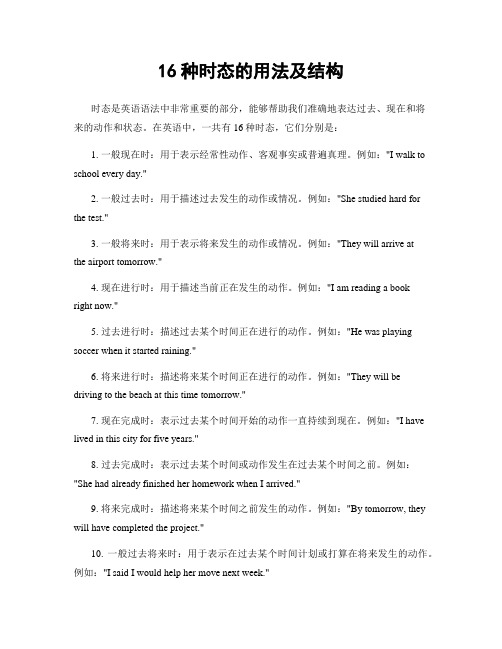
16种时态的用法及结构时态是英语语法中非常重要的部分,能够帮助我们准确地表达过去、现在和将来的动作和状态。
在英语中,一共有16种时态,它们分别是:1. 一般现在时:用于表示经常性动作、客观事实或普遍真理。
例如:"I walk to school every day."2. 一般过去时:用于描述过去发生的动作或情况。
例如:"She studied hard for the test."3. 一般将来时:用于表示将来发生的动作或情况。
例如:"They will arrive atthe airport tomorrow."4. 现在进行时:用于描述当前正在发生的动作。
例如:"I am reading a bookright now."5. 过去进行时:描述过去某个时间正在进行的动作。
例如:"He was playing soccer when it started raining."6. 将来进行时:描述将来某个时间正在进行的动作。
例如:"They will be driving to the beach at this time tomorrow."7. 现在完成时:表示过去某个时间开始的动作一直持续到现在。
例如:"I have lived in this city for five years."8. 过去完成时:表示过去某个时间或动作发生在过去某个时间之前。
例如:"She had already finished her homework when I arrived."9. 将来完成时:描述将来某个时间之前发生的动作。
例如:"By tomorrow, they will have completed the project."10. 一般过去将来时:用于表示在过去某个时间计划或打算在将来发生的动作。
小学英语时态总结及用法

小学英语时态总结及用法英语时态是英语语法中非常重要的一部分,它用来表示动作发生的时间。
在学习英语的过程中,正确使用时态是非常重要的,因为时态的错误使用会导致语法错误,影响交流的准确性。
因此,我们需要对英语时态进行总结,并掌握其用法。
一、一般现在时。
一般现在时表示经常性或习惯性的动作,或者客观真理。
例如,I go to school every day.(我每天去学校。
)Water boils at 100 degrees Celsius.(水在100摄氏度时沸腾。
)。
二、一般过去时。
一般过去时表示在过去某个时间发生的动作。
例如,I watched a movie last night.(昨晚我看了一部电影。
)She lived in Paris for ten years.(她在巴黎住了十年。
)。
三、一般将来时。
一般将来时表示将来某个时间要发生的动作。
例如,I will visit my grandparents next week.(下周我要去拜访我的祖父母。
)They are going to have a party tomorrow.(他们明天要举办一个派对。
)。
四、现在进行时。
现在进行时表示现在正在进行的动作。
例如,He is reading a book now.(他现在正在看书。
)They are playing basketball in the playground.(他们在操场上打篮球。
)。
五、过去进行时。
过去进行时表示在过去某个时间正在进行的动作。
例如,I was studying when she called me.(她给我打电话时,我正在学习。
)They were playing games at that time.(那个时候他们在玩游戏。
)。
六、将来进行时。
将来进行时表示将来某个时间正在进行的动作。
例如,I will be sleeping at 10 o'clock tonight.(今晚十点我将在睡觉。
六种时态的用法

英语六种时态用法
英语的六种时态是:现在时、过去时、将来时、现在进行时、过去进行时和将来进行时。
1. 现在时 (Present Tense)
用法:描述当前发生的动作或状态。
例句: I eat an apple every day.
翻译: 我每天吃一个苹果。
2. 过去时 (Past Tense)
用法:描述过去发生的动作或状态。
例句: She walked to the park yesterday.
翻译: 她昨天走到公园。
3. 将来时 (Future Tense)
用法:描述将来要发生的动作或状态。
例句: They will visit us next week.
翻译: 他们下周将会拜访我们。
4. 现在进行时 (Present Continuous Tense)
用法:描述正在发生的动作或状态。
例句: He is studying English now.
翻译: 他现在正在学习英语。
5. 过去进行时 (Past Continuous Tense)
用法:描述过去正在发生的动作或状态。
例句: They were playing football at that time. 翻译: 那时他们正在踢足球。
6. 将来进行时 (Future Continuous Tense)
用法:描述将来某个时间正在进行的动作或状态。
例句: She will be reading a book tomorrow.
翻译: 她明天将会在读一本书。
英语十六种时态及用法
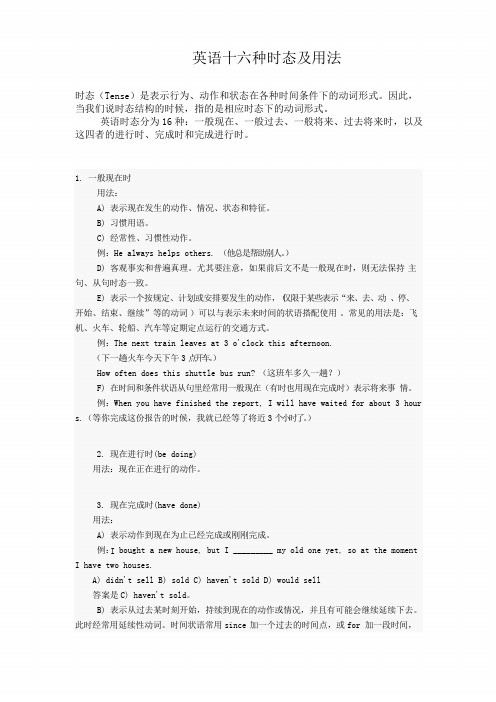
( I 英语十六种时态及用法时态(Tense )是表示行为、动作和状态在各种时间条件下的动词形式。
因此, 当我们说时态结构的时候,指的是相应时态下的动词形式。
英语时态分为 16 种:一般现在、一般过去、一般将来、过去将来时,以及 这四者的进行时、完成时和完成进行时。
1. 一般现在时 用法:A) 表示现在发生的动作、情况、状态和特征。
B) 习惯用语。
C) 经常性、习惯性动作。
例:He always helps others. (他总是帮助别人。
)D) 客观事实和普遍真理。
尤其要注意,如果前后文不是一般现在时,则无法保持 主 句、从句时态一致。
E) 表示一个按规定、计划或安排要发生的动作, 仅限于某些表示“来、去、动 、停、开始、结束、继续”等的动词 )可以与表示未来时间的状语搭配使用 。
常见的用法是:飞机、火车、轮船、汽车等定期定点运行的交通方式。
例:The next train leaves at 3 o'clock this afternoon.(下一趟火车今天下午3点开车。
)How often does this shuttle bus run? (这班车多久一趟?)F) 在时间和条件状语从句里经常用一般现在(有时也用现在完成时)表示将来事 情。
例:When you have finished the report, I will have waited for about 3 hour s.(等你完成这份报告的时候,我就已经等了将近3个小时了。
)2. 现在进行时(be doing)用法:现在正在进行的动作。
3. 现在完成时(have done)用法:A) 表示动作到现在为止已经完成或刚刚完成。
例: bought a new house, but I _________ my old one yet, so at the moment I have two houses.A) didn't sell B) sold C) haven't sold D) would sell答案是 C) haven't sold 。
八大时态的结构与用法

八大时态的结构与用法
英语中主要有八大时态,它们的结构和用法如下:
- 现在时:表示经常性或习惯性的动作或状态,或者表示现在正在进行的动作。
常用的句式结构是:主语+动词原形+其他。
- 现在进行时:表示正在进行的动作,或者现在的某个动作正在发生。
常用的句式结构是:主语+be动词(am/is/are)+动词的现在分词+其他。
- 现在完成时:表示过去某个时间开始,一直持续到现在的动作或状态。
常用的句式结构是:主语+have/has+动词的过去分词+其他。
- 过去时:表示过去某个具体时间发生的动作或状态。
常用的句式结构是:主语+动词的过去式+其他。
- 过去进行时:表示过去某个具体时间正在进行的动作。
常用的句式结构是:主语+was/were+动词的现在分词+其他。
- 过去完成时:表示过去某个时间之前完成的动作。
常用的句式结构是:主语+had+动词的过去分词+其他。
- 将来时:表示将来某个时间会发生的动作或状态。
常用的句式结构是:主语+will+动词原形+其他。
- 将来进行时:表示将来某个具体时间正在进行的动作。
常用的句式结构是:主语+will be+动词的现在分词+其他。
英语时态的用法小结
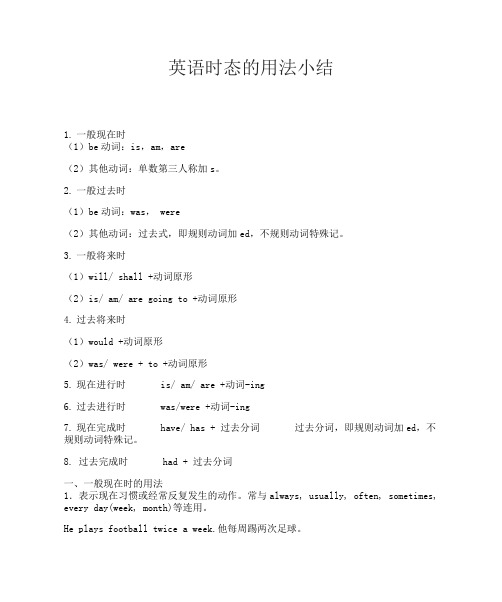
英语时态的用法小结
1.一般现在时
(1)be动词:is,am,are
(2)其他动词:单数第三人称加s。
2.一般过去时
(1)be动词:was, were
(2)其他动词:过去式,即规则动词加ed,不规则动词特殊记。
3.一般将来时
(1)will/ shall +动词原形
(2)is/ am/ are going to +动词原形
4.过去将来时
(1)would +动词原形
(2)was/ were + to +动词原形
5.现在进行时 is/ am/ are +动词-ing
6.过去进行时 was/were +动词-ing
7.现在完成时 have/ has + 过去分词过去分词,即规则动词加ed,不规则动词特殊记。
8. 过去完成时 had + 过去分词
一、一般现在时的用法
1.表示现在习惯或经常反复发生的动作。
常与always, usually, often, sometimes, every day(week, month)等连用。
He plays football twice a week.他每周踢两次足球。
英语中的几种时态的用法

英语中的几种时态的用法英语中的几种时态有简单现在时、进行时、过去时、过去进行时、将来时、将来进行时、过去将来时等。
1. 简单现在时:表示经常性的动作、习惯、常理等,或者描述真理、事实等。
- I go to the gym every morning.(我每天早上去健身房。
)- Water boils at 100 degrees Celsius.(水在100摄氏度沸腾。
)2. 进行时:表示正在进行的动作或现阶段的状态。
- She is studying in the library right now.(她正在图书馆学习。
)- They are having dinner at the restaurant.(他们正在餐厅吃晚餐。
)3. 过去时:表示过去发生的动作或状态。
- He visited his grandparents last weekend.(他上周末去看望了他的祖父母。
)- We lived in New York for several years.(我们在纽约住了几年。
)4. 过去进行时:表示过去某一时刻正在进行的动作。
- I was reading a book when the phone rang.(电话响时我正在读书。
)- They were playing basketball in the park yesterday.(昨天他们在公园里打篮球。
)5. 将来时:表示将来发生的动作或状态。
- She will travel to Europe next month.(她下个月将前往欧洲旅行。
)- We are going to have a meeting tomorrow.(明天我们将举行会议。
)6. 将来进行时:表示将来某一时刻正在进行的动作。
- I will be studying for my exam when you arrive.(当你到达时,我将正在备考。
- 1、下载文档前请自行甄别文档内容的完整性,平台不提供额外的编辑、内容补充、找答案等附加服务。
- 2、"仅部分预览"的文档,不可在线预览部分如存在完整性等问题,可反馈申请退款(可完整预览的文档不适用该条件!)。
- 3、如文档侵犯您的权益,请联系客服反馈,我们会尽快为您处理(人工客服工作时间:9:00-18:30)。
各种时态的用法一、一般现在时构成:a.主动:动词原形(主语是第三人称单数时,谓语动词要加s/es);be动词要用am,is,are。
b.被动:am / is / are + 过去分词用法:①一般现在时表示经常性或习惯性的动作,常用频度副词sometimes, often, always, usually, seldom及时间副词every day, night, week, month, year, in the morning, in the afternoon, in the evening, at night做状语。
如:I go to school at 6 every morning. 每天早上我6点去上学。
②一般现在时表示客观存在及普遍真理。
如:Summer follows spring. 春天之后是夏天。
The sun rises in the east. 太阳从东方升起。
注意:此种用法即使出现在过去的语境中,仍用一般现在时。
如:I learned that the earth goes around the sun when I was in primary school.我在小学就学过地球是围绕太阳转的。
③一般现在时表示格言或警句。
如:Pride goes before a fall. 骄兵必败。
④一般现在时表示目前的情况或状态,常跟时间副词now连用。
如:I am a teacher.Peter writes good Chinese but does not speak well.He lives in Beijing now,⑤以here,there等开始的倒装句,表示动作正在进行。
如:Here comes the bus. = The bus is coming.There goes the bell. = The bell is ringing.⑥习惯性的爱好或行为。
如:I like dancing while she likes singing. 我喜欢跳舞,而她喜欢唱歌。
We get up at six.⑦在某些习惯表达法中,常用一般现在时表示已经发生过的动作或存在的状态。
如:They say Wu Dong is ill. 据说吴东病了。
The paper says the disease is under control.报纸上说这种病已经得到了控制。
The diagram tells us that people’s living is improving.这份图标告诉我们,人们的生活正在改善。
⑧在下列情况下表示将来:a.在(时间、条件等)状语从句中用一般现在时代替一般将来时。
如:I will give it to him as soon as I see him. 我一看见他就会交给他。
He will come if you invite him. 如果你请他,他会来的。
Suppose he doesn’t agree, what shall we do? 假如他不同意,那怎么办?I shall do as I please. 我高兴怎么做就怎么做。
He will continue the work no matter what happens.不管发生什么情况他都要继续这项工作。
b.在the more…the more…(越…越…)句型中,前者通常用一般现在时代替一般将来时,因为前者相当于条件状语从句。
如:The harder you study, the better results you will get.你学习越努力,成绩就越好。
c.在make sure(certain), see to it, mind, care, matter后的宾语从句的谓语动词用一般现在时代替一般将来时。
如:See to it that you are not late again. 注意,别再迟到了。
d.表示按计划或时间表将要发生的动作,并且一定要做的事情。
通常有时间状语。
如: The plane takes off at 11:30 and arrives in Shanghai at 1:20.飞机十一点半起飞,一点二十分抵达上海。
注:只限于少数动词能这样用,如begin, start, end, finish, stop, go, come, leave, sail, arrive, return, close, open等。
二、一般过去时构成:a.主动:过去式(动词原形后加ed/d或不规则变化)b.被动:was/were + 过去分词用法:①表示在过去某个时间所发生的动作或所处的状态,常与yesterday, last week, in 1978, just now, a moment ago, the other day等连用。
如:He was here just now. 他刚才还在这里。
What did you do yesterday? 你昨天做了什么?②在过去一段时间内的经常性或习惯性动作。
如:We often played together when we were children. 我们小时候常在一起玩。
注:表示过去经常发生的动作还可用used to和would。
如:He used to smoke a lot, but he doesn’t now. 他过去经常抽烟,但现在不抽了。
Whenever we were in trouble, he would help us.每当我们遇到困难,他都会帮助我们。
③表示主语过去的特征或性格。
如:At that time she was very good at English. 那时她英语学得很好。
④用在状语从句中表示过去将来。
如:He said he would wait until they came back. 他说他会等他们回来。
⑤一般过去时有时可以表示现在,多与want,hope,wonder,think,intend等动词连用,使语气更为委婉。
如:I wondered if you could help me. 不知你能不能帮我一下。
有时用一般过去时也是时态一致的需要。
如:I didn’t know you were here. 没想到你在这里。
注意:1.表示一系列的动作,尽管有先后都用一般过去时,最后两个动词之间用and连接。
如: He hoped the door, rushed out and then disappointed.他打开门,冲了出去,然后就消失了。
2.注意在语境中理解“我刚才/原来还不…”。
如:-- Your phone number again? I didn’t quite catch it.请再说一次你的电话号码,好吗?我刚才没听清楚。
-- It’s 2566666.三、一般将来时用法:一般将来时表示将来发生的事。
常与tomorrow,next year等时间状语连用。
构成:通常有以下七种方式表示将来,注意它们各自的区别。
①由will加动词原形构成,当主语是第一人称时,也可以用shall加动词原形。
如:Telephone me this evening, I’ll be at home.I’ll (shall/will) do a better job next time. 下次我要干得好些。
a. will还可用来表示同意或“不能”。
如:-- Come and see me tomorrow. 明天来找我。
-- Yes, I will.-- Don’t be late.-- No, I won’t.The car won’t start. 车开不了了。
(表功能)Oil and water will not mix. 油和水没法混在一起。
b. 表示临时的决定,只能用will加动词原形。
如:-- You’ve left the light on. 你忘记关灯了。
-- Oh, so I have. I’ll go and turn it off. 啊!那我去关。
c. 在“祈使句 + and/or + 陈述句”句型中,陈述句中只能用will或情态动词加动词原形。
如:Work hard, and you will pass the exam.d. 在条件句中表示将来不用will,而用一般现在时、be going to(打算),或be to(为人所控制的动作)等。
若你见到在条件句中用了will,那will就是表示“愿意”的情态动词。
如:Let her do that if she will. 如果她愿意,就让她那样做。
被动:will/shall + be + 过去分词①am/is/are going to + 动词原形,表示主语的意图或打算将来做的事。
如:What are you going to do tomorrow?The play is going to be produced next month.注意:已有迹象表明将要发生的事,只能用am/is/are going to + 动词原形。
如:Look at the dark clouds, it’s going to rain. 看那乌云,快要下雨了。
被动:am/is/are + going to + be + 过去分词②am/is/are + to do仅用于表示正式的公务安排、公共指示、义务、禁止、命令、注定要发生某事等。
如:You’re to deliver these flowers before 10. 你在十点之前把这些花送去。
You are to (=should) report to the police. 你应该报警的。
You’re not to (=mustn’t ) tell him anything about our plans.你不要把我们的计划透露给他。
注意:a.这与不定式作表语不同:My idea is to go there today. 我的意思是今天就去那里。
b.be to强调客观安排或受人指示而做某事,be going to则强调主观的打算或计划。
被动:am/is/are + to be +过去分词③am/is/are about to + 动词原形,表示即将或马上要做的事。
如:He is about to leave for Beijing.注意:be about to do 不嫩与表示将来时间的状语连用。
被动:am/is/are + about + to be + 过去分词④am/is/are on the point of + V-ing,表示“就要做某事”,也不能与表示将来的时间状语连用。
